Pop Culture
Meet the Indigenous Artist Behind the Unsettling Works on the Hit TV Series ‘The Curse’
Santa Fe-based artist Frank Buffalo Hyde recreated some of his earlier works for the show.
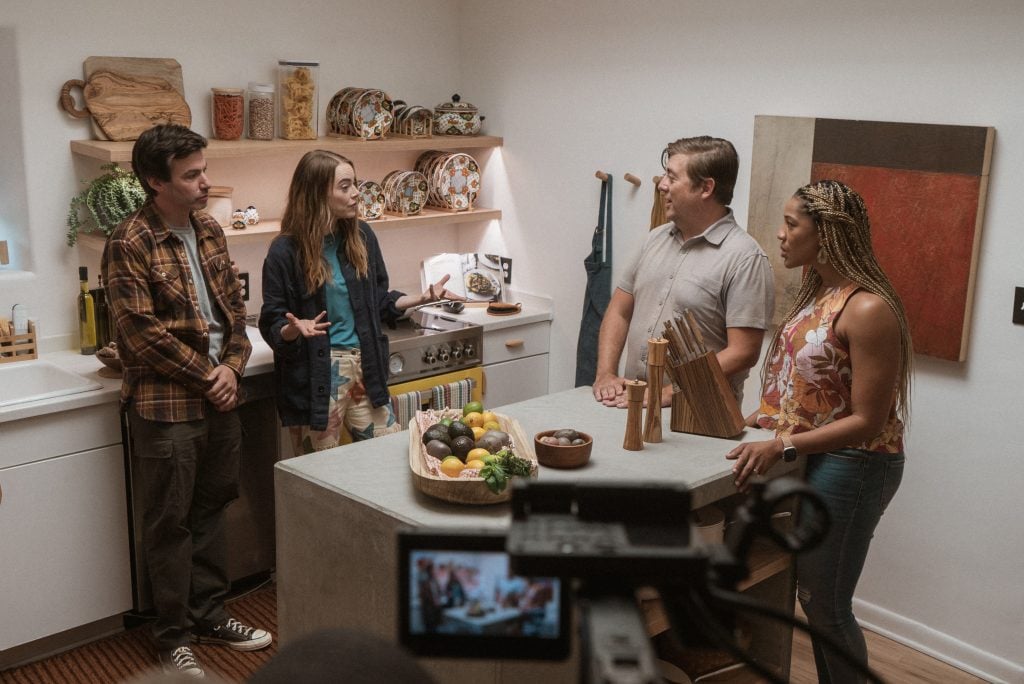
Much has been said about the ways in which art in Showtime’s TV series The Curse underscores its pointed and sardonic depiction of gentrification as well as the art world’s ugly, money-driven aspect. Doug Aitken-inspired mirrored houses that Asher Siegel (played by Nathan Fielder, who co-created the series with Benny Safdie) and his wife Whitney (Emma Stone) design are central to the plot, but so is the artwork of one character, Cara Durand (Diné/Tlingit artist Nizhonniya Austin).
Artworks appear in many of the scenes where Asher and Whitney attempt to pitch their eco-friendly “passive homes” in New Mexico via a home renovation HGTV show. In the second episode of the dark comedy, the couple attends the opening of a show by local emerging Native artist Cara in an bid to gain her friendship, under the guise of using her art in their homes and winning over the local pueblo whose land falls in their developing path.
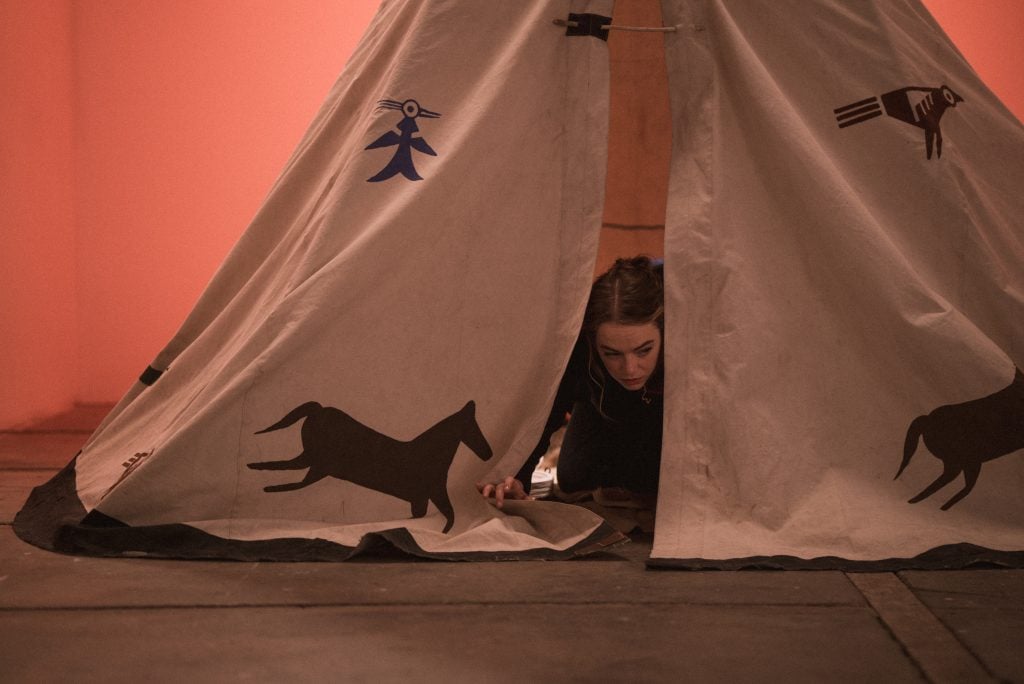
Emma Stone as Whitney in The Curse (2023). Photo: Richard Foreman Jr./A24/Paramount+ with SHOWTIME.
Throughout the show, Whitney lauds Cara as a rising art-world star who is pushing the boundaries in Native art. For her exhibition, there are mixed-media works featuring offensive Native stereotypes and a performance piece inside a teepee where the artist silently meets with visitors one-on-one, offering them turkey that she cuts from a meat-slicer. While some of the works in the exhibition, including the teepee scene, were conceived and constructed as a group effort (and all of the pottery came from the family of producer Ashley Browning who is from the Santa Clara Pueblo), many others throughout the show were provided by one Santa Fe-based artist—Frank Buffalo Hyde.
Born in Santa Fe and raised on the Onondaga Nation, south of Syracuse, New York, Hyde spent his childhood observing bison on a nearby field and learning about his culture. His work incorporates symbols of popular culture, modern technology, Native American imagery in an accessible Pop art style that underscores his social critiques of cultural appropriation.
“The great thing about contemporary Indigenous art is that it’s influenced by everything going on today, but with the advantage of cultural identity and knowledge,” he said.
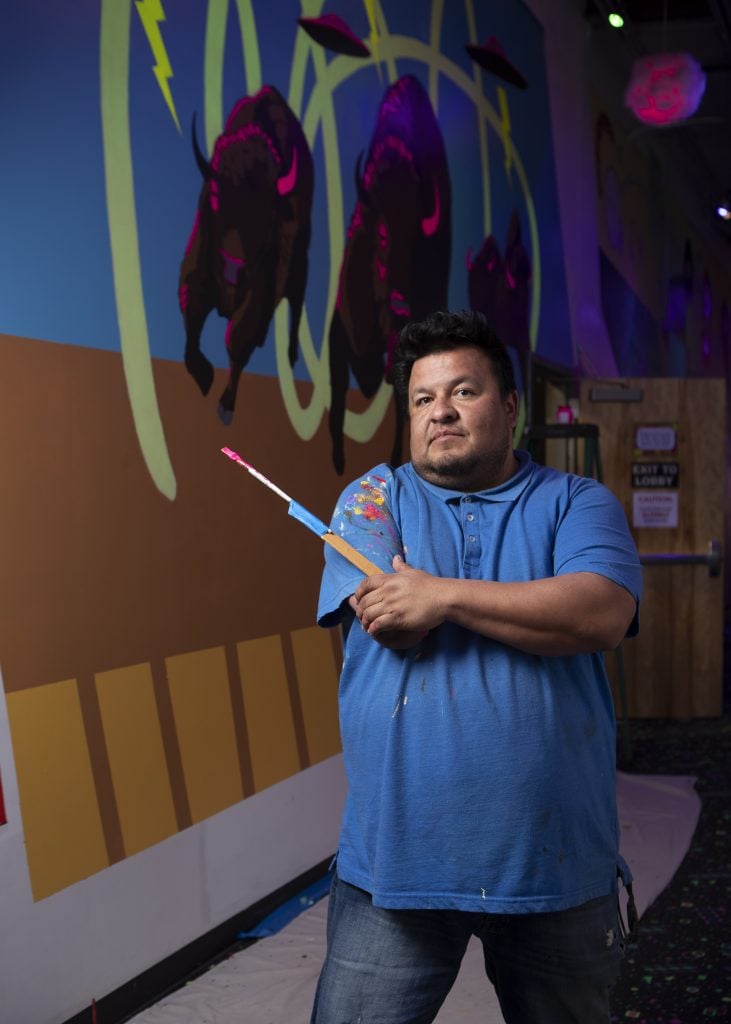
Frank Buffalo Hyde. Photo courtesy of the artist.
For his museum debut in 2012, sardonically titled “Ladies and Gentlemen, This Is the Buffalo Show,” at the Museum of Contemporary Native Art, Hyde filled the space with depictions of the buffalo that doubled down on and subverted its Anglo-American associations. (The name Buffalo was passed down by Hyde’s great-grandmother, a member of the Nez Perce tribe.) His paintings depicted the animal with helicopters and spaceships hovering in the background, its skull with Eagle wings protruding from its sides, and its likeness reduced to a cultural symbol. Elsewhere, its form was reimagined as an abstract and red-checkered sculpture titled Genetically Engineered (2012).
Hyde’s involvement on The Curse was a natural fit, said production designer Katie Byron. “It didn’t feel right to manufacture [the artwork] ourselves and it didn’t feel right putting Cara’s name on an existing artist’s work. Instead, we wanted to hire an actual Indigenous artist to help us build that world,” she explained. “Frank’s work is subversive, playful, and important.”
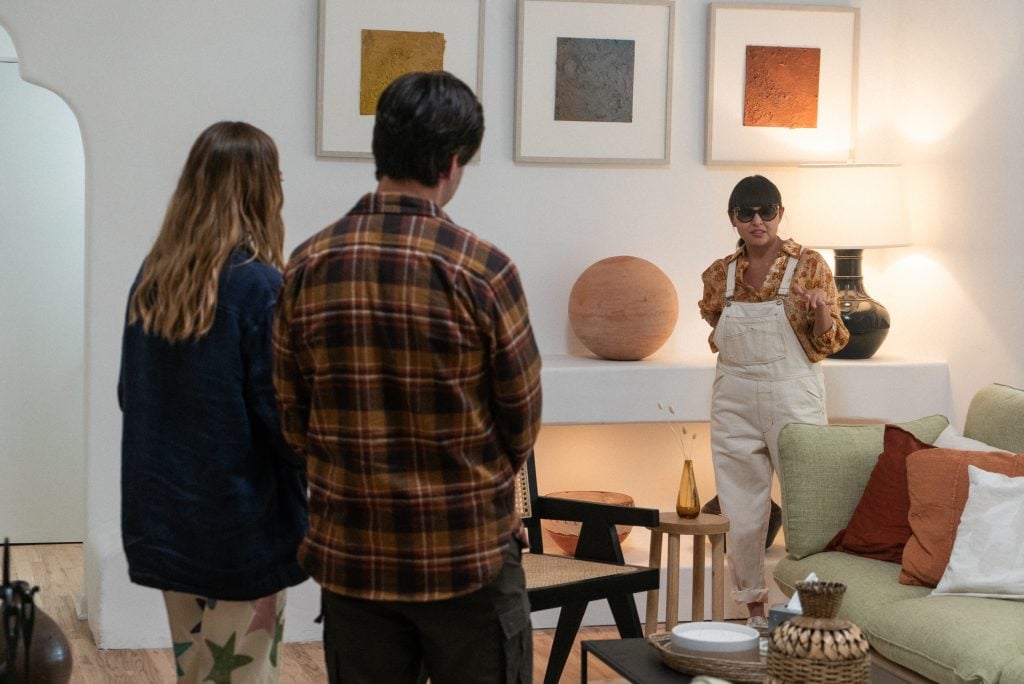
Emma Stone as Whitney, Nathan Fielder as Asher, and Nizhonniya Luxi Austin as Cara Durand in The Curse (2023). Photo Credit: Richard Foreman Jr./A24/Paramount+ with SHOWTIME.
Hyde first heard of the opportunity from a former associate who put him in touch with the show’s set decorator Rachael Ferrara. “They were looking for a younger Indigenous artist that was sort of edgy and angry, and I have certainly been that in the past and still am in some regards in different situations,” Hyde said, adding that many of his works selected for the show came from early on in his career.
“There’s always the expectation versus reality of what contemporary Native art is and can be,” he continued. “An artist will do something that is personal to them and speaks to an Indigenous audience, but in the gallery setting, there’s always this expectation of it being more Indigenous, so some artists deliver that stereotype to the art market and then other artists push the envelope in the other way.”
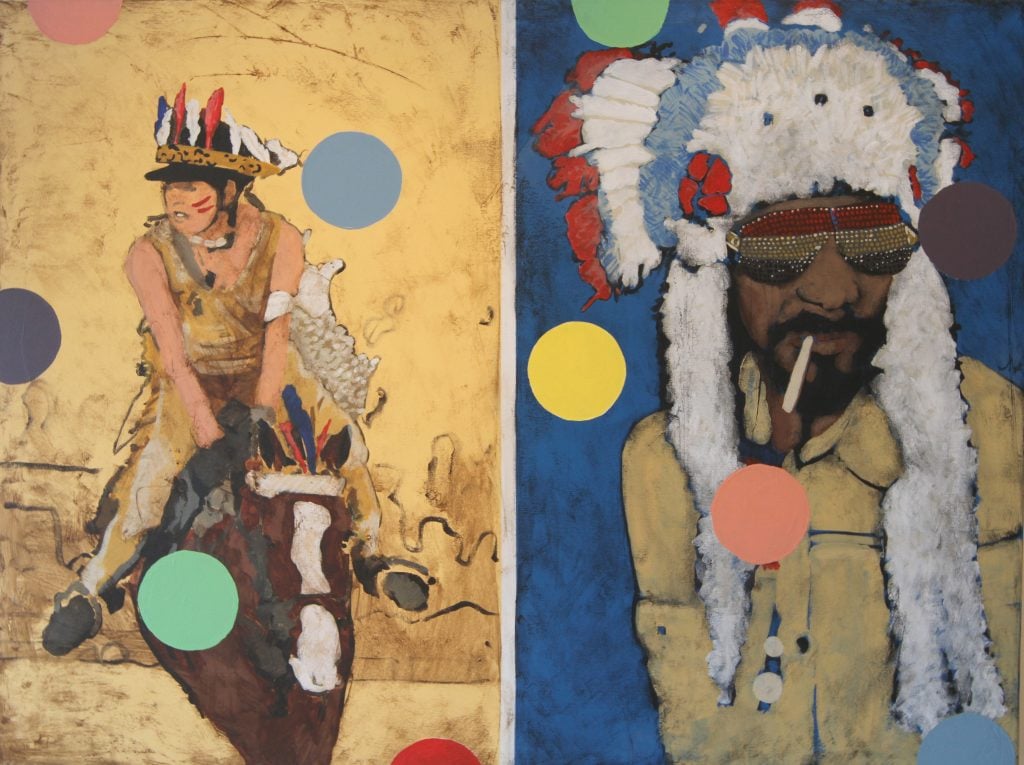
Frank Buffalo Hyde, In-Appropriate #2 (2023) at the All My Relations Gallery. Photo: Bruce Bisping/Star Tribune via Getty Images.
For Hyde, the proximity of Cara’s story in The Curse is crucial and meaningful—even if there is still work to be done with centering Indigenous stories in popular culture at large.
“As long as Indigenous stories and characters are controlled or highlighted by non-Indigenous machines, you’re gonna have some sort of disconnect,” he conceded. Yet, he emphasized, “each attempt or foray into Indigenous representation is an important step in the right direction.”
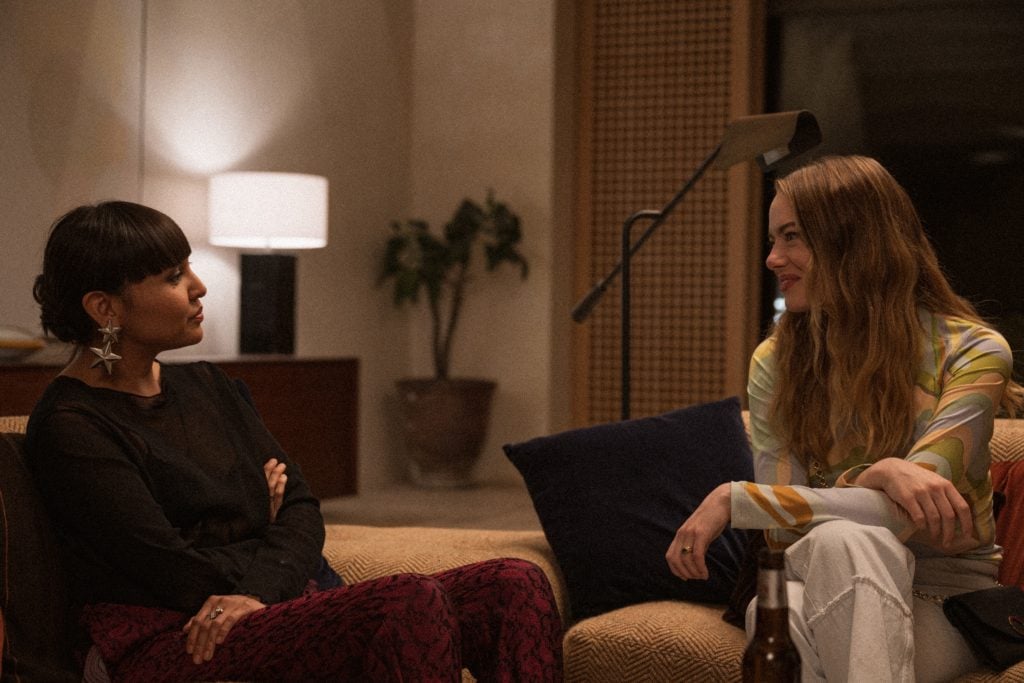
Nizhonniya Luxi Austin as Cara Durand and Emma Stone as Whitney in The Curse (2023). Photo: Anna Kooris/A24/Paramount+ with SHOWTIME.
For Cara’s infamous solo exhibition scene, Hyde consulted on the final touches (how the artworks would be hung on the walls and priced) after many of the assemblages were already made, including the display of stolen bobble heads and the teepee room. Other works, like the singed cigar store Indian on the gallery wall, were a product of Hyde, who worked with the art department to get the desired charred effect with blow torches.
For another work, Hyde revisited his sculpture American Prayer (2004) to create a similar version of the TV monitor totem pole. “I’m an artist that’s used to working fast and always making new things, so to get a chance to revisit one of my older pieces and build it for a different audience was very meta,” he said.
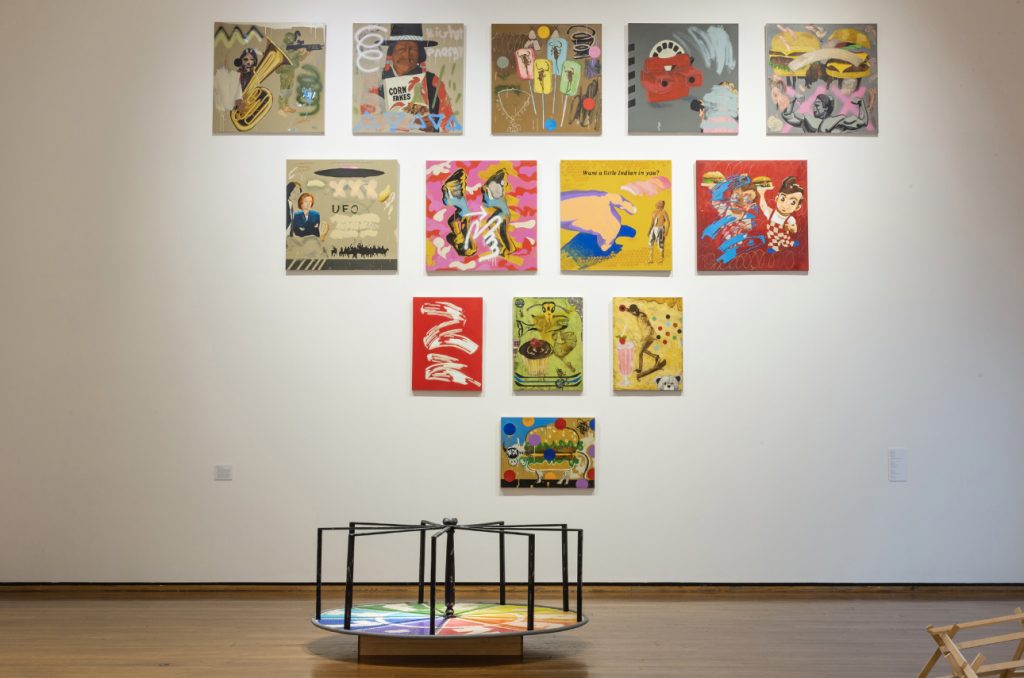
Installation view of “Frank Buffalo Hyde: Native Americana” at Everson Museum of Art. Photo courtesy of the artist.
Coming off the production for series, Hyde started percolating new ideas for installations. His exhibition last summer at the Everson Museum of Art in Syracuse, New York, titled “Native Americana,” featured an entire room of installations. Now, he is preparing for a show at All My Relations gallery in Minneapolis where he will continue to explore the relationship between painting and sculpture.
“In the way that television and movies have foreshadowing, for me, working on the sculptures conceptually and in real life for the show gave me energy and the willingness to go that extra step, to go into three-dimensional work,” he said.





